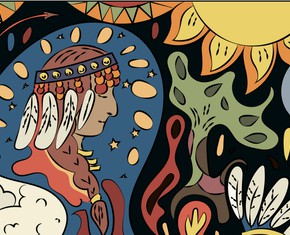The views expressed in our content reflect individual perspectives and do not represent the authoritative views of the Baha'i Faith.
It’s time to demystify prophecies—not all of them, of course. Some prophecies are genuine. Some are not. Which is which? How do we know?
One way is to apply the Baha’i principle of the “harmony of science and religion” to the interpretation of prophecy.
“Science,” as it pertains to the academic study of religion, basically means “scholarship.” This is not to say that scholarship is right, or even that it speaks with one voice of consensus. After all, scholars debate, just as those in the so-called “hard” sciences do. Just as scientists propose different theories to explain various physical phenomena, scholars in the study of religion offer their own explanations regarding religious texts. Prophecies are among them. These texts are typically referred to as “apocalyptic literature.”
To illustrate this point, let’s return to those texts that predict the coming of “Shah Bahram” (also spelled “Shah Wahram”), a key figure in the popular Zoroastrian imagination regarding events that will occur at the climax of religious history.
Bear in mind that Zoroastrianism is now a dying religion, as its number of adherents continues to decline. According to one well-known Zoroastrian prayer, if good fortune is to ever to revisit the “Good Religion” again, it must happen soon:
So that whatever (good) has to happen may happen fast, [may] the givers of justice and righteousness, the ones who adorn the world, and those (divine beings) who are the righteous of the righteous—Hoshedar of Zarathosht; Peshotan of Vishtasp, and the successful and courageous Behram Yazad (Shah Behram Varzavand)—arrive soon to declare the Good Religion! May the law of the Good Religion be connected with the rule of Ahura Mazda! May the good commandments and the Good Religion spread through the land of Iran! – “Chithrem Buyat” prayer
Of the three messiahs invoked here, two are mentioned in Baha’i texts. Shoghi Effendi states that the Bab may be regarded as “the ‘Ushídar-Máh’ referred to in the Zoroastrian scriptures” (God Passes By, p. 58), while Baha’u’llah is said to be “to the Zoroastrians the promised Sháh-Bahrám” (Ibid., p. 94). These truth-claims are not a stamp of the authenticity of the prophecies themselves, but simply address popular Zoroastrian expectations.
Now let’s return to the Shah Bahram prophecies themselves. One of the most renowned Baha’i academics, the late Dr. Amin Banani, Professor Emeritus of Persian Literature and History at the University of California, Los Angeles (UCLA), passed away in 2013. A year before, in 2012, a collection of essays, dedicated to his memory, was published. The second essay is a brilliant analysis of texts foretelling the appearance of Shah Bahram Varjavand, by Touraj Daryaee, titled “On the Coming of a Zoroastrian Messiah: A Middle Persian Poem on History and Apocalypticism in Early Medieval Islamic Iran,” in Converging Zones: Persian Literary Tradition and the Writing of History: Studies in Honor of Amin Banani, pp. 5–14.
In brief, Professor Daryaee revisits the prophecy quoted in the previous article, and offers his own retranslation. In it, he points to the existence of another “Bahram” in Persian history that may have influenced and shaped this prophecy, as Professor Daryaee explains:
It is this messianic activity that has conjoined itself with the historical figures/kings of the late antique Iran. K. Czeglédy first suggested that Wahrām ī Warzāwand should be identified with the rebel Wahrām ī Čōbīn who defeated the Turks and brought the empire glory and security on its eastern frontier. … But there is another historical figure who may be considered as one that not only is seen in the apocalyptic texts as the savior but who is also mentioned in other Middle Persian texts. …
The other son of Yazdgerd III, Wahrām (Aluohan in Chinese sources), attempted to recapture the lost territories from the Arab Muslims. C.G. Cereti, in a seminal article on this figure, has shown that the poem we are dealing with here is probably related to the activity of this son of Yazdgerd III, who died in 710 CE. Thus, we have the incorporation of three different strands of divine and historical figures into one being presented to us in a poem in the early Islamic period, as Wahrām died in the eighth century CE. This piece of evidence also pushes the date of the poem to the post-Sasanian period. – Ibid., pp. 8–9.
So what are the three different strands of divine and historical figures into one being presented to us in a poem in the early Islamic period? They are: (1) the Zoroastrian “deity of offensive victory,” whose name is Verethragna; (2) the rebel, Wahrām ī Čōbīn (King of Persia in 590–591 CE); and (3) Wahrām (known as “Aluohan,” when living exile, in China), son of Yazdgerd III (CE). Exemplary traits from all three were woven together, then projected into the future.
So what does this scholarship tell us about the Zoroastrian prophecies of Shah Bahram? It tells us that future events are based on past events (what scholars call “vaticinia ex eventu”), but, this time, with hoped-for—yet impossible—outcomes!
Remember that Shah Bahram was supposed to come with an army of 1,000 war elephants, presumably equipped with turrets, with archers positioned, each armed with a myriad arrows. Today, such a battle cannot be conceived, as the technology of warfare abandoned the use of war elephants long ago.
So Baha’u’llah’s claim to be Shah Bahram go far beyond the literal prophecies themselves. These Zoroastrian prophecies are clearly modeled on prior traditions, as described above. To their credit, these prophecies sustained Zoroastrian hopes for centuries.
But these prophecies are relics of the past, even if believed in the present, in hopes for the future. Baha’u’llah gently disenchants the Shah Bahram prophecies by showing that the world can best be renewed through peace and prosperity—not by recourse to war, whether through war elephants or modern-day weapons of mass destruction.
The Baha’i principle of the harmony of science and religion, as applied to Zoroastrian prophecies, is seen in the results of historical scholarship, as shown above. As for the “religious” side of this “harmony,” belief in the fulfillment of certain prophecies can be rational insofar as literal interpretations are discarded in favor of a spiritual understanding, free of all former prejudices and wishes for vengeance.
Zoroastrian prophecies do not present Islam in a kind light. In a religiously pluralistic world, these centuries-old resentments and prejudices cannot abide. Shoghi Effendi, quoting Baha’u’llah, writes:
To the priestly caste, holding sacerdotal supremacy over the followers of the Faith of Zoroaster, that same Voice, identifying itself with the voice of the promised Sháh-Bahrám, has declared: “O high priests! Ears have been given you that they may hearken unto the mystery of Him Who is the Self-Dependent, and eyes that they may behold Him. Wherefore flee ye? The Incomparable Friend is manifest. He speaketh that wherein lieth salvation. Were ye, O high priests, to discover the perfume of the rose garden of understanding, ye would seek none other but Him, and would recognize, in His new vesture, the All-Wise and Peerless One, and would turn your eyes from the world and all who seek it, and would arise to help Him.” – Shoghi Effendi, The Promised Day Is Come, p. 77.
















Comments
Sign in or create an account
Continue with Googleor